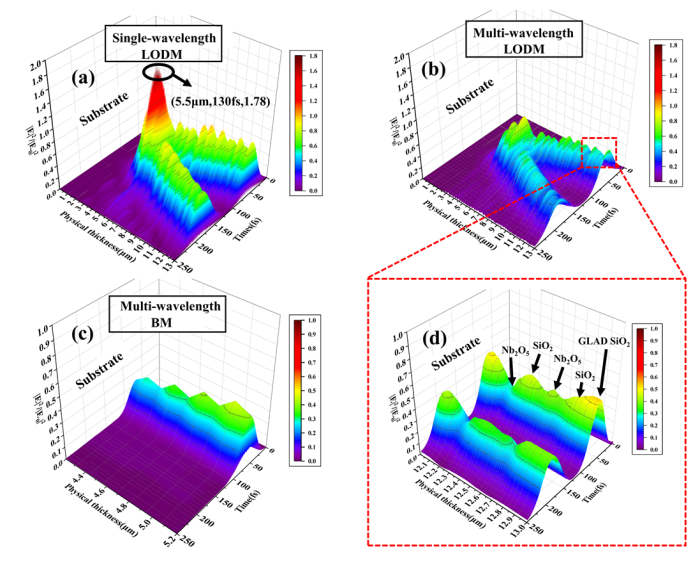Recently, the research team from Shanghai Institute of Optics and Fine Mechanics (SIOM), Chinese Academy of Sciences (CAS) has made new progress in the research of low-dispersion oscillation broadband mirrors with high-threshold. Related research results have been published on Applied Surface Science on September 20, 2021.
The petawatt-level ultra-short ultra-intense laser pulse is the laser with the highest intensity known in the world, providing with unprecedented extreme experimental conditions. With the development of laser output energy and the continuous narrowing of output pulse duration, the requirements of thin films have gradually increased. Broadband mirror is one of the most important and most critical components in ultra-short ultra-intense laser systems, and its performance directly restricts the output of high-power pulsed lasers. In 100 PW laser system, the spectral bandwidth exceeds 200 nm, which is a challenge for broadband high-threshold mirrors.
The researchers conducted research on the damage resistance performance of the low-dispersion oscillation broadband mirror (LODM, with a bandwidth of 240 nm) based on the sculptured layer. On the premise that the intensity of the standing wave field(SWF) is 4.5 times that of the Bragg reflector(BM), the threshold of the LODM is still equivalent to that of the BM. Traditional monochromatic SWF analysis can explain the damage behavior of simple films such as BMs, but for dispersive mirrors with more complex structures, the residence time of the pulse inside the film is longer. In addition, the femtosecond pulse has the characteristics of wide bandwidth and short pulse duration. Therefore, the internal electric field of the dispersive mirror under the action of the femtosecond pulse is constantly changing with time, and the traditional steady-state SWF is no longer suitable for analyzing its damage behavior.
The researchers put forward an analysis model of the time-domain dynamic electric field, and analyzed the transmission process of the ultrashort pulse in the dispersive mirror from the perspective of the spatio-temporal evolution of femtosecond laser pulses, which makes up for the shortcomings of the traditional SWF model in explaining the laser damage of the broad-spectrum ultrashort pulse. The analysis results show that due to the effect of the bandwidth and the time difference of the electric field formation between different frequencies, the actual electric field intensity in the depth of the dispersive mirror will be smaller than the SWF intensity. This achievement is expected to provide new design ideas for the subsequent design and preparation of higher threshold broadband mirrors.
This work was supported by National Key R&D program of China; National Natural Science Foundation of China ; Shanghai Sailing Program; NSAF Fund Jointly set up by the National Natural Science Foundation of China and the Chinese Academy of Engineering Physics; the Strategic Priority Research Program of CAS; the Youth Innovation Promotion Association, Chinese Academy of Sciences.

Fig. 1. (a) DEFI distribution of LODM with wavelength of 800 nm; (b) multi-wavelength DEFI distribution of LODM; (c) multi-wavelength DEFI distribution of BM. (d) the local DEFI with a thickness of 1 μm on the surface of Fig. 1(b). (Image by SIOM)]
Article website:
https://doi.org/10.1016/j.apsusc.2021.151251
Contact:
WU Xiufeng
General Administrative Office
Shanghai Institute of Optics and Fine Mechanics, CAS
Email: xfwu@siom.ac.cn
Web: http://english.siom.cas.cn/